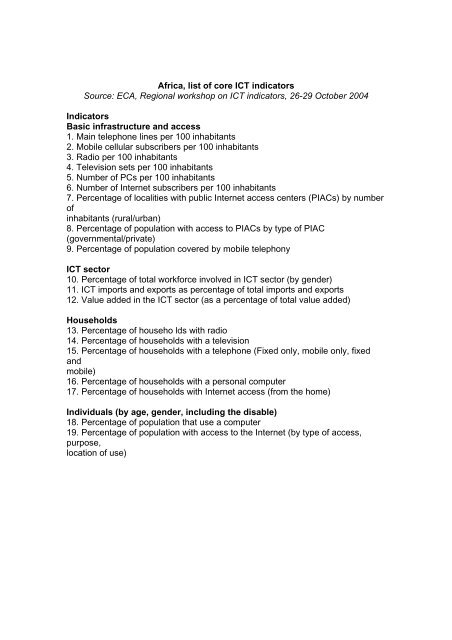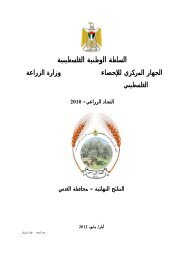Africa, list of core ICT indicators Source: ECA, Regional workshop ...
Africa, list of core ICT indicators Source: ECA, Regional workshop ...
Africa, list of core ICT indicators Source: ECA, Regional workshop ...
Create successful ePaper yourself
Turn your PDF publications into a flip-book with our unique Google optimized e-Paper software.
<strong>Africa</strong>, <strong>list</strong> <strong>of</strong> <strong>core</strong> <strong>ICT</strong> <strong>indicators</strong><br />
<strong>Source</strong>: <strong>ECA</strong>, <strong>Regional</strong> <strong>workshop</strong> on <strong>ICT</strong> <strong>indicators</strong>, 26-29 October 2004<br />
Indicators<br />
Basic infrastructure and access<br />
1. Main telephone lines per 100 inhabitants<br />
2. Mobile cellular subscribers per 100 inhabitants<br />
3. Radio per 100 inhabitants<br />
4. Television sets per 100 inhabitants<br />
5. Number <strong>of</strong> PCs per 100 inhabitants<br />
6. Number <strong>of</strong> Internet subscribers per 100 inhabitants<br />
7. Percentage <strong>of</strong> localities with public Internet access centers (PIACs) by number<br />
<strong>of</strong><br />
inhabitants (rural/urban)<br />
8. Percentage <strong>of</strong> population with access to PIACs by type <strong>of</strong> PIAC<br />
(governmental/private)<br />
9. Percentage <strong>of</strong> population covered by mobile telephony<br />
<strong>ICT</strong> sector<br />
10. Percentage <strong>of</strong> total workforce involved in <strong>ICT</strong> sector (by gender)<br />
11. <strong>ICT</strong> imports and exports as percentage <strong>of</strong> total imports and exports<br />
12. Value added in the <strong>ICT</strong> sector (as a percentage <strong>of</strong> total value added)<br />
Households<br />
13. Percentage <strong>of</strong> househo lds with radio<br />
14. Percentage <strong>of</strong> households with a television<br />
15. Percentage <strong>of</strong> households with a telephone (Fixed only, mobile only, fixed<br />
and<br />
mobile)<br />
16. Percentage <strong>of</strong> households with a personal computer<br />
17. Percentage <strong>of</strong> households with Internet access (from the home)<br />
Individuals (by age, gender, including the disable)<br />
18. Percentage <strong>of</strong> population that use a computer<br />
19. Percentage <strong>of</strong> population with access to the Internet (by type <strong>of</strong> access,<br />
purpose,<br />
location <strong>of</strong> use)
Business<br />
20. Percentage <strong>of</strong> businesses with computers<br />
21. Percentage <strong>of</strong> businesses with Internet access<br />
22. Percentage <strong>of</strong> businesses with a website<br />
23. Percentage <strong>of</strong> employees using PCs<br />
24. Percentage <strong>of</strong> employees using the Internet<br />
25. Percentage <strong>of</strong> businesses receiving orders over Internet<br />
26. Percentage <strong>of</strong> businesses placing orders ove r Internet<br />
27. Percentage <strong>of</strong> businesses with an intranet
28. Value <strong>of</strong> orders received over the Internet (as a percentage <strong>of</strong> total value <strong>of</strong><br />
orders)<br />
Education<br />
29. Percentage <strong>of</strong> students enrolled in tertiary education having Internet access<br />
for<br />
students for study purposes<br />
30. Enrolled Student to PC ratio (in primary, secondary schools and tertiary<br />
education)<br />
31. Percentage <strong>of</strong> students enrolled in tertiary education in an <strong>ICT</strong> field or an<br />
<strong>ICT</strong>dominated<br />
field (<strong>of</strong> the total number <strong>of</strong> students) (by gender)<br />
32. Percentage <strong>of</strong> <strong>ICT</strong>-qualified teachers in primary and secondary schools (<strong>of</strong><br />
the total<br />
number <strong>of</strong> teachers)<br />
33. Percentage <strong>of</strong> tertiary education institutions with e- learning courses (<strong>of</strong> the<br />
total<br />
number <strong>of</strong> tertiary education institutions)<br />
34. For what purpose do students/teachers use computers/Internet (% for E-<br />
mail, research,<br />
employment opportunities, application s<strong>of</strong>tware, etc.)<br />
Government<br />
35. Ratio <strong>of</strong> availability <strong>of</strong> PCs to number <strong>of</strong> staff<br />
36. Percentage <strong>of</strong> government <strong>of</strong>fices with Internet access<br />
37. Percentage <strong>of</strong> government <strong>of</strong>fices and agencies with a website<br />
38. Percentage <strong>of</strong> government employees with Internet access from the <strong>of</strong>fice<br />
39. Percentage <strong>of</strong> government workers that use <strong>ICT</strong>s<br />
40. Purpose <strong>of</strong> use: (per cent) for e- mail, research, database work, geomatics,<br />
application<br />
s<strong>of</strong>tware, etc<br />
Agriculture<br />
41. Percentage <strong>of</strong> agricultural population and extension workers involved in the<br />
exploitation and deployment <strong>of</strong> <strong>ICT</strong>s to the sector<br />
42. Typology <strong>of</strong> usage <strong>of</strong> <strong>ICT</strong>s in the agricultural sector (per cent in research and<br />
development, business, weather, prices, etc.)<br />
43. Number <strong>of</strong> local web-sites and data bases with agricultural information and<br />
content<br />
Health<br />
44. Percentage <strong>of</strong> health institutions using <strong>ICT</strong>s (by type <strong>of</strong> health institution:<br />
private<br />
clinic, government, university hospital, pharmacy etc…)<br />
45. Geographic distribution <strong>of</strong> health institutions with computers, telephone and<br />
Internet
connectivity<br />
46. Percentage <strong>of</strong> health pr<strong>of</strong>essionals that use <strong>ICT</strong>s for medical purposes<br />
47. Purpose <strong>of</strong> usage and % in tele- medicine, e- mail, research (health<br />
information,<br />
continuing medical education or distance learning, health promotion (including<br />
health<br />
information systems), database, S<strong>of</strong>tware applications, etc<br />
48. Percentage <strong>of</strong> local web-sites and data bases with medical information




